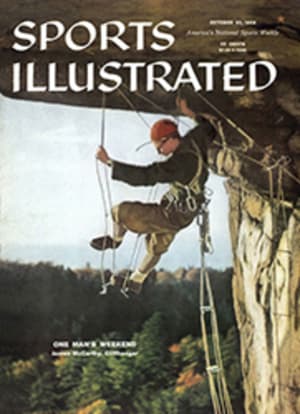
One Man's Way to Reach the Summit
To anyone not well acquainted with the advanced techniques of mountaineering, Climber James McCarthy, an NYU undergraduate of Port Washington, New York, shown in the picture on the opposite page, would seem to have reached the end of his ropes and be hung up now like a giant spider in his own web, with little chance of going higher or getting back down. Actually, 25-year-old McCarthy, a climber of seven years' experience, is in no trouble at all. He is attacking a difficult overhang and, using the common methods and tools of the sport, has the situation well in hand. As the pictures on the following pages show, McCarthy has moved carefully and deliberately out under this ledge by driving pitons into the rock. McCarthy inserts into the snap link in each piton light, ladderlike stirrups in which he can stand and get purchase to work farther out and up the overhang. As he progresses outward, he is guyed up by two tension ropes which are handled by an unseen companion 40 feet below.
This overhang presents the sort of problem any advanced climber might face on any number of imposing mountains around the world. This particular overhang, however, is merely an unusually tough formation McCarthy found in the old, worn-down Shawangunk Mountains near his home. McCarthy spends many weekends in this area hunting out interesting problems that help keep him fit for the tougher tests he gets during the summers climbing the Dolomites, the French Alps and the Rockies. "Any hard climb anywhere," McCarthy points out, "is preparation, and even in such small mountains it is an end in itself, enjoyable for its own sake."
Bracing himself in the stirrups he has strung from pitons hammered into a high ridge of the Shawangunk Mountains, James McCarthy begins to work his way up the sheer face of an overhang.
Dangling in space, his only support the spider's web of ropes and stirrups he has firmly pitoned into rock, high-angle specialist McCarthy edges way carefully out under ceiling of six-foot overhang. This particular climb is considered the most difficult in the 200-to 250-foot high cliffs which, for a three-mile stretch, afford some of the toughest rock climbing in the U.S.
Rounding Overhang, McCarthy lets foot hang free before pounding in pitons in preparation for last, deliberate stage of rock climb.
At rest at last, McCarthy looks like a Gothic gargoyle on a cathedral spire. "Climbers," he says, "are people who relax in thin positions."
SIX PHOTOS
KIM MASSIE

